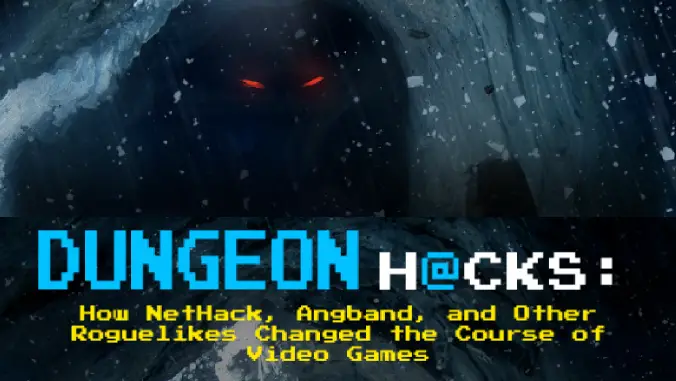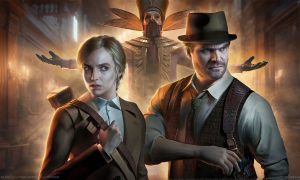Nowadays, it’s hard to be a gamer and not come across the word ‘roguelike’ regularly. The term now occupies that uncomfortable spot between a concise summary of a game feature and a flat-out buzzword, taking its place alongside words like ‘massively multiplayer’ and ‘open-world exploration’. But what sets the roguelike phenomenon apart from the rest is the history not just of the word or even its gaming namesake, but the genre itself – stretching back before the advent of the modern internet, and even before the original ‘Rogue’ itself. That history, and the creative processes and friendships that undergird it, is summarized and described with lucidity in David L. Craddock’s Dungeon H@cks: How Nethack, Angband and Other Roguelikes Changed the Course of Video Games.
In Dungeon H@cks, Craddock covers the foundational roguelike games – a genre which stretches all the way back to the late 1970s. From Nethack and Advanced Dungeons of Mystery all the way back to (of course) Rogue and the comparatively obscure but technically ‘first’ Beneath Apple Manor, the focus of this book isn’t a laborious description of game features or a dry description of facts. Instead, Craddock manages to pleasantly retell the history of the roguelike genre in a compact flowing way, emphasizing the backgrounds of the games’ developers, the motivations behind their creating of these games as well as some of the key features added, and more. The transitions between the personal details of the programmers, the technical aspects of their games, and how these games ultimately ended up influencing each other is handled well, making Dungeon H@cks not just a very informative book, but a well-crafted one.
The titles covered by Dungeon H@cks should be familiar to any hardcore old-school roguelike player. Making the cut in major ways are Beneath Apple Manor, Rogue, Sword of Fargoal, Hack, Nethack, Moria, Angband, and Ancient Dungeons of Mystery (ADOM). Each get a chapter devoted to them, filling in details about their creators’ lives, goals, inspirations and development processes. Supplementary information is grouped together under a ‘Side Quests’ section, offering up additional information alluded to in the game-dedicated chapters – ‘footnotes, but lengthier’ in essence. The final section of the book is entitled Bonus Rounds, further expanding on the games and people presented through Dungeon H@cks.
Clocking in at around almost two hundred pages of actual content and information, Dungeon H@cks is a book that’s going to resonate with two target audiences in particular. First, aspiring game developers eager for insight into the creative process at work with some of gaming’s most well-established, old-school roguelike games. Second, hobbyist scholars of gaming history who enjoy discovering the fundamental design influences that helped make the gaming scene what it is today. It’s the former in particular who may really benefit from this book, since Craddock provides insight into the recounted thought processes behind a slew of not just successful but genre-building games – right up the alley of any up and coming developer wanting personal examples of how successful games and features really came to be.
Dungeon H@cks: How Nethack, Angband and Other Roguelikes Changed the Course of Video Games is a solid title shining a spotlight on a genre that goes well beyond a buzzword in Steam or App Store sales. It’s an entertaining, insightful book offering up considerable information and commentary while still managing to be enjoyable to read.
Victor Grunn has been a gamer since the days of single-button joysticks and the Atari 800XL. When not lamenting the loss of the Ultima series or setting people on fire in Team Fortress 2, he's an aspiring indie game developer and freelance writer.


 Buy Now
Buy Now
 Buy Now
Buy Now
 Buy Now
Buy Now
 Buy Now
Buy Now
 Buy Now
Buy Now
 Buy Now
Buy Now















